
The Solar-Terrestrial Centre of Excellence (STCE) is a collaborative network of the Belgian Institute for Space Aeronomy, the Royal Observatory of Belgium and the Royal Meteorological Institute of Belgium.
 |
Published by the STCE - this issue : 24 Apr 2014. The Solar-Terrestrial Centre of Excellence (STCE) is a collaborative network of the Belgian Institute for Space Aeronomy, the Royal Observatory of Belgium and the Royal Meteorological Institute of Belgium. |
| Archive of the newsletters | Subscribe to this newsletter by mail |
A strong M7 flare occurred in NOAA 2036 on 18 April (peak at 13:03UT). This sunspot region developed on disk in just a few days (image underneath), was magnetically complex but had not produced any strong flare until that day.
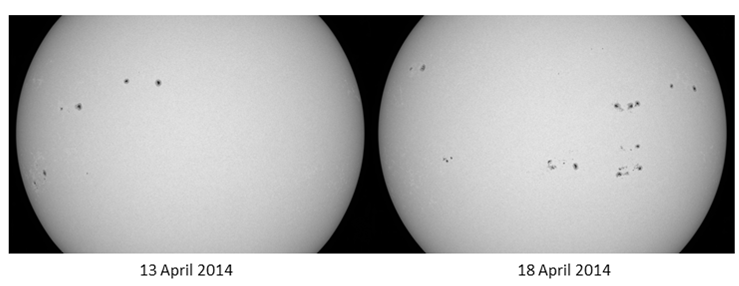
The flare seems to get initiated by a bright jet near the middle cluster of sunspots (image underneath at 12:35UT), apparently destabilizing the overlying magnetic loops (12:43UT) and creating a reconnection and flare. The creation of a transient coronal hole south of the active region can be observed, indicating the ejection of material into space. There was also an EIT-wave (http://stce.be/news/241/welcome.html) associated to this event, which can be seen sweeping towards the Sun's east limb in PROBA2/SWAP difference imagery (one image subtracted from the previous one).

The flare was also accompanied by a proton event (the fifth this year, see http://umbra.nascom.nasa.gov/SEP/). The first protons started to arrive about 1 hour after the onset of the flare, and about 30 minutes after the peak. It was a minor event, reaching a maximum of 58pfu (particle flux unit) early on 19 April.
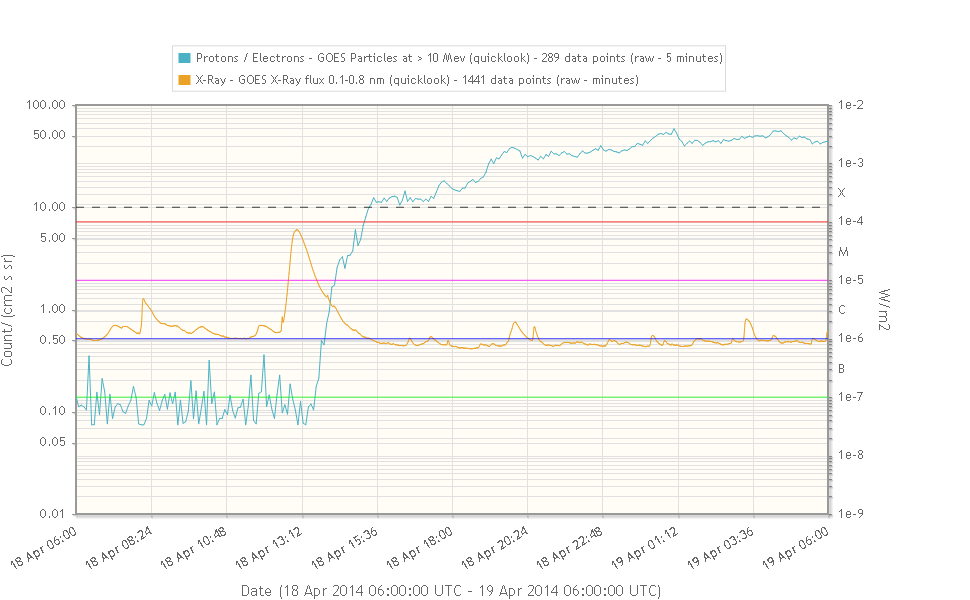
Radio-bursts accompanying this flare event were observed by the Solar Radio Observatory in Humain (image underneath). The type III burst recorded at 12:35UT coincides with the appearance of the jet seen in EUV (extreme ultraviolet) and a brief hick-up in x-ray flux. Also a Type II burst can be seen (from about 12:54 till 13:03UT) which is indicative of a shock wave moving through the solar atmosphere. The speed of this shock wave was determined to be near 800km/s.

Based on the EUV and radio observations, the appearance of a coronal mass ejection (CME) shortly after the flare was no surprise. It showed as a halo around the Sun, indicating that part of this CME was directed towards Earth. The recorded speed was about 1000km/s, but the bulk of the plasma cloud was directed away from the Earth. Around 11:30UT on 20 April, Earth suffered the impact from this CME. Wind speed reached 750km/s, but the magnetic field of the CME was initially positive, eventually resulting in only small negative (southward) excursions. Active conditions were recorded, with a brief episode of a minor geomagnetic storm.
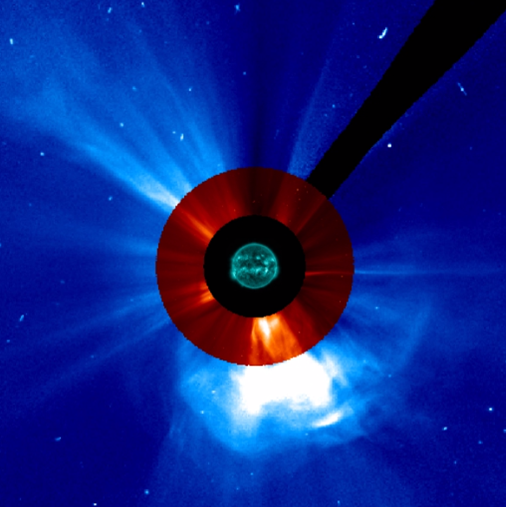
This movie at http://youtu.be/Mrde7doR8rY first shows the sunspot regions in white light, then three clips in SDO/AIA filters of increasing temperature (AIA 304-171-131) overlaid on the white light imagery, a clip combining three SDO-filters (AIA 304-171-094), the PROBA2/SWAP difference imagery (EIT-wave), and ends with the combined SDO/AIA and SOHO/LASCO imagery (CME).
Credits - Data and imagery were taken from PROBA2/SWAP (http://proba2.oma.be/ssa), Humain Radioastronomy Station (http://www.sidc.be/humain/), SDO (http://sdo.gsfc.nasa.gov/data/), SOHO (http://sohowww.nascom.nasa.gov/), Staff (http://sun-ts-dev.oma.be/), and (J)Helioviewer (http://helioviewer.org/).
Fourteen active regions were reported by NOAA during the week (with numbers between 2032 and 2045) with 10 of them producing in total 67 flares: 65 C-flares and 2 M-flares. AR 2035 (blue) and AR 2036 (Red) dominate the chart below and thus the flaring scenery. It where also these 2 groups that were responsible for the M-flares on April 16 and 18.
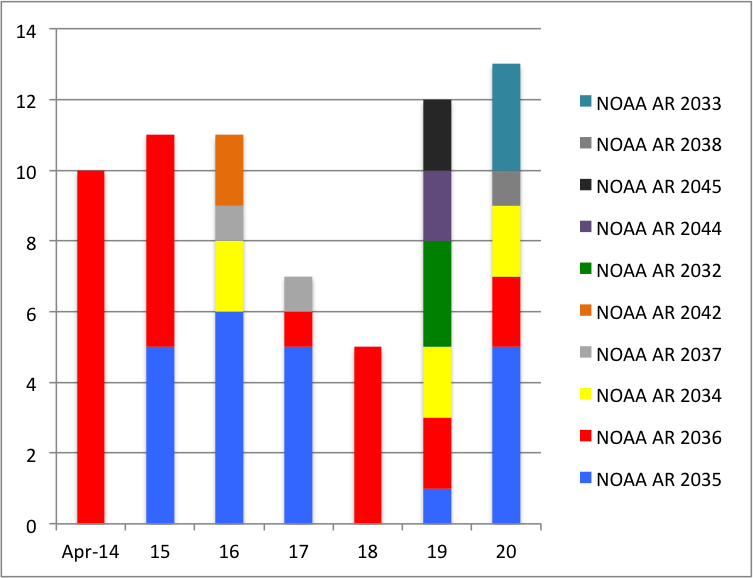
The M1.0 flare peaked at 19:59 UT on April 16 in the NOAA AR 2035 (Catania number 24). The flare was associated with an EIT wave and a weak coronal dimming, but the associated CME was narrow and did not arrive at the Earth.
An M7.3 flare peaked at 13:03 UT on April 18 in the NOAA AR 2036 (Catania number 25). The flare is visible on the SDO/AIA 193 movie as a light flash in the SE of the solar disk: http://www.stce.be/movies/20140418_aia_193.mp4
Solar Demon (http://solardemon.oma.be) detected a solar dimming at the time of the flare. This indicates that a CME is possibly associated with the event. And indeed, a full halo CME appeared in the SOHO/LASCO FOV at 13:25 UT. The resulting ICME arrived at the Earth on April 20 (see Review of Geomagnetic Activity).
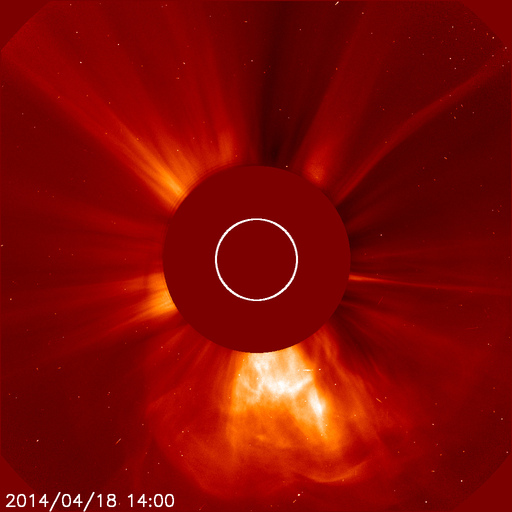
The halo CME also produced a proton event at energies above 10 MeV that lasted for almost two days. Right after the arrival of the associated shock-like structure at the Earth on April 20 (see below), the proton flux at energies above 10 MeV decreased to values below the threshold of the proton event.
Check the SOHO/LASCO chronograph difference movie: the halo CME comes into the C2 FOV less than 30 minutes after the flare peak, the white and black dots appearing after the eruption are the protons that hit the detecter of the chronograph.
http://www.stce.be/movies/20140418_d2.mpg
| DAY | BEGIN | MAX | END | LOC | XRAY | OP | 10CM | TYPE | Cat | NOAA |
| 16 | 1954 | 1959 | 2004 | S14E9 | M1.0 | 1N | II/2 | 24 | 2035 | |
| 18 | 1231 | 1303 | 1320 | M7.3 | 1000 | CTM/1III/1V/2IV/2VII/2II/2 | 25 | 2036 |
| LOC: approximate heliographic location | TYPE: radio burst type |
| XRAY: X-ray flare class | Cat: Catania sunspot group number |
| OP: optical flare class | NOAA: NOAA active region number |
| 10CM: peak 10 cm radio flux |
In the beginning of the week the Earth was situated inside a slow solar wind flow and the geomagnetic conditions were quiet. Late on April 16 an interplanetary sector boundary arrived. The Earth passed from a sector with a magnetic field pointing towards the Sun (Phi between roughly 270 and 360 degrees) to a sector with a magnetic field pointing away from the Sun (Phi between roughly 90 and 180 degrees). The blue lines shows the inward and outward interplanetary magnetic field (IMF).
The sector boundary crossing was followed by a compression region at the interface between a slow and a faster solar wind flow. The plasma in a compression region is compressed in terms of density (orange) and magnetic field (blue, second graph). The solar wind speed increased gradually to around 500 km/s on April 18 (see ACE graph below)
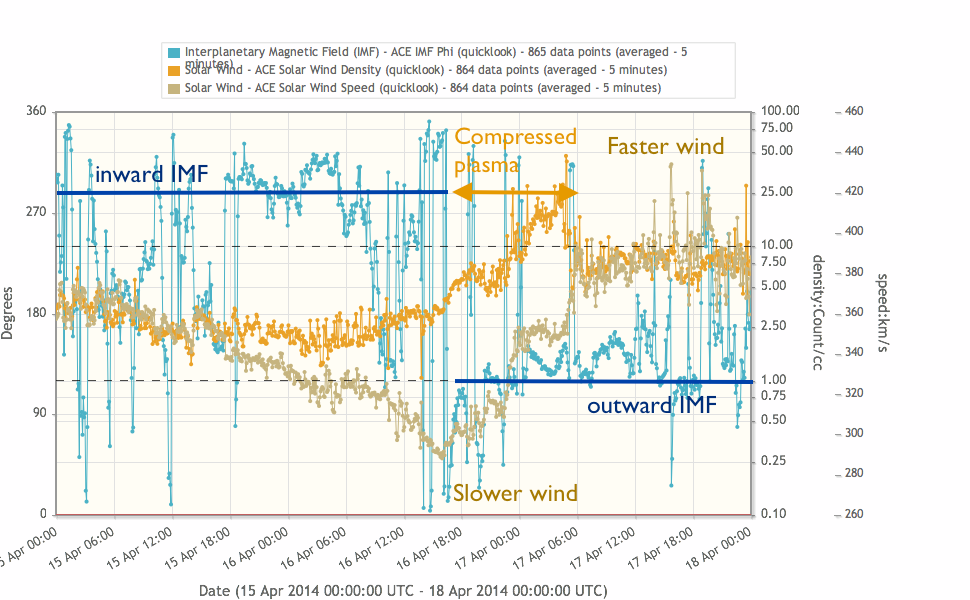
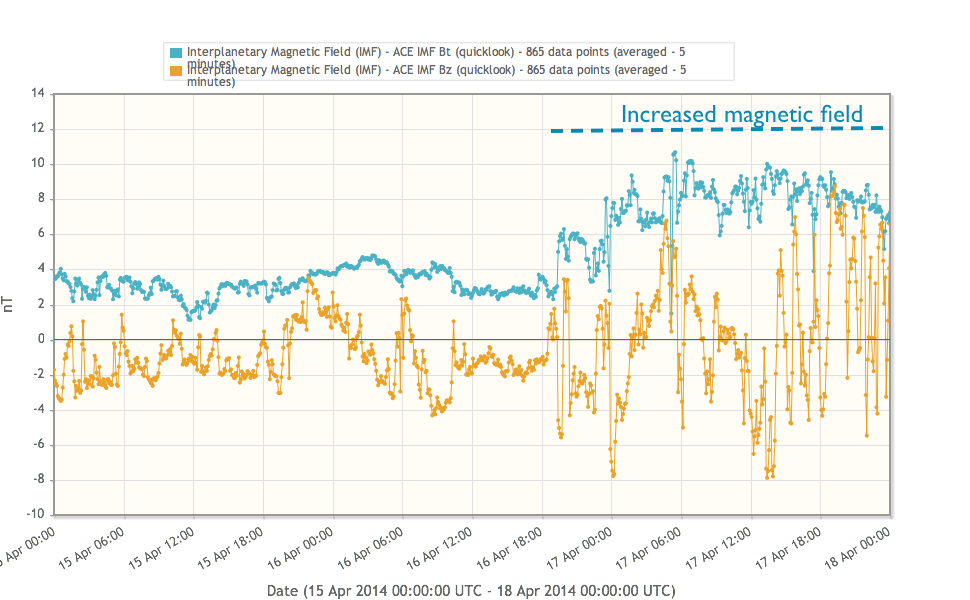
The geomagnetic situation remained mostly quiet, with only several occasional intervals of K = 4 reported by Dourbes, IZMIRAN and NOAA on April 19.
The arrival of an interplanetary shock-like structure was detected on April 20. ACE recorded jumps of the solar wind speed, temperature, and the interplanetary magnetic filed (IMF) magnitude at 10:23 UT. SOHO/CELIAS detected a jump of the density at 10:22 UT, but the jump of the speed was detected only 20 to 30 minutes later.
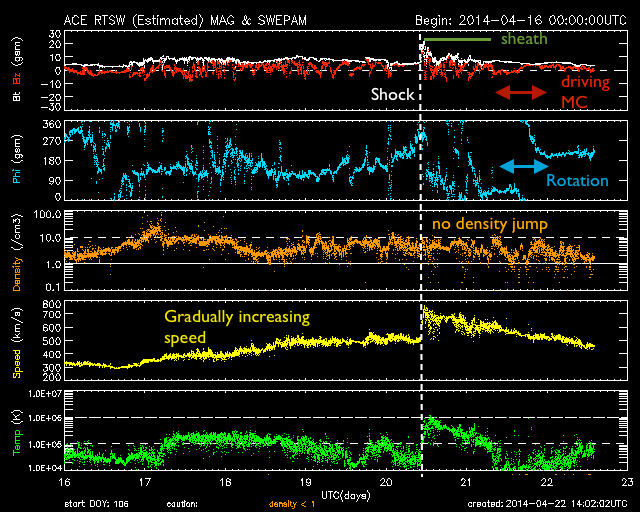
Therefore, this discontinuity does not seem to be a typical ICME-driven fast forward shock as ACE did not detect a jump of the density at all, and jumps of the density and the solar wind speed detected by SOHO/CELIAS were not simultaneous. The structure was followed by a sheath-like region (green line in ACE graph above) that lasted until the arrival of the driving magnetic cloud (MC, red arrow) on April 21. The magnetic field vector in the MC rotated slowly from +/- 45 to +/- 180 degrees (Phi, blue arrow). This ICME corresponds to the halo CME observed on the Sun on April 18. During intervals of the strongest IMF magnitude in the sheath-like region (up to 22 nT), the north-south IMF component Bz was not particularly strong and fluctuated in its direction. Only active and minor geomagnetic storm conditions (K index of 4 and 5) resulted, as reported by Dourbes, IZMIRAN and NOAA. Weak geomagnetic impact of this event is probably due to a glancing encounter with the ICME, as evidenced by the long interval (almost a day) between the arrivals of the shock-like structure and of the magnetic cloud.
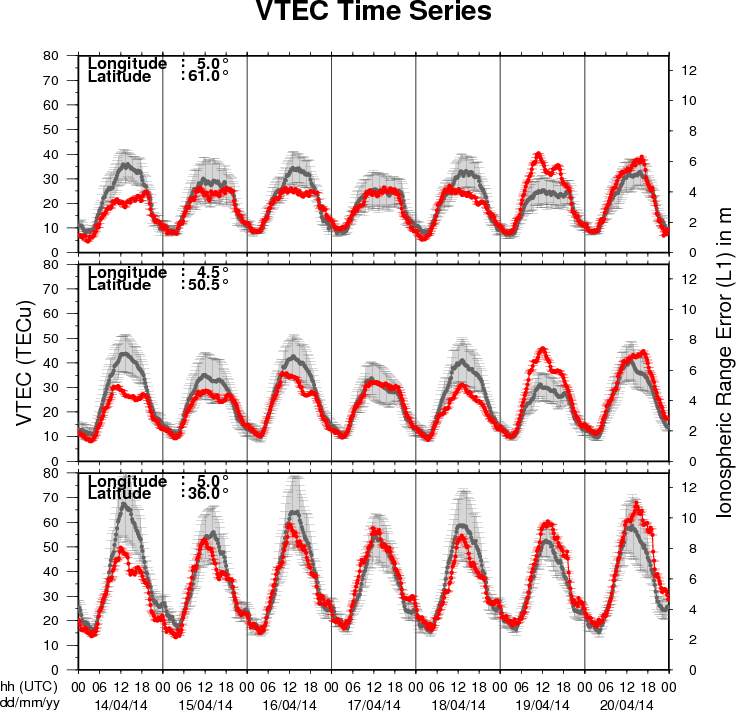
The figure shows the time evolution of the Vertical Total Electron Content (VTEC) (in red) during the last week at three locations:
a) in the northern part of Europe(N61°, 5°E)
b) above Brussels(N50.5°, 4.5°E)
c) in the southern part of Europe(N36°, 5°E)
This figure also shows (in grey) the normal ionospheric behaviour expected based on the median VTEC from the 15 previous days.
The VTEC is expressed in TECu (with TECu=10^16 electrons per square meter) and is directly related to the signal propagation delay due to the ionosphere (in figure: delay on GPS L1 frequency).
The Sun's radiation ionizes the Earth's upper atmosphere, the ionosphere, located from about 60km to 1000km above the Earth's surface.The ionization process in the ionosphere produces ions and free electrons. These electrons perturb the propagation of the GNSS (Global Navigation Satellite System) signals by inducing a so-called ionospheric delay.
See http://stce.be/newsletter/GNSS_final.pdf for some more explanations ; for detailed information, see http://gnss.be/ionosphere_tutorial.php
Start : 2014-04-27 - End : 2014-05-02
The EGU General Assembly 2014 will bring together geoscientists
from all over the world to one meeting covering all disciplines of
the Earth, planetary and space sciences. The EGU aims to provide a
forum where scientists, especially early career researchers, can
present their work and discuss their ideas with experts in all
fields of geosciences.
Start : 2014-06-10 - End : 2014-06-11
The STCE workshop 'Inter-Calibration and Degradation of EUV
Instruments' aims at understanding the differences observed between
the various instruments observing in the SXR-EUV range and at
analyzing the ageing effects that affect their results. It targets
imagers as well as spectrometers and photometers.
The workshop will be followed by two days of working sessions
(June 12-13) organized by the Solar EUV Irradiance Working Group
(also supported by the STCE). These working sessions are in the
continuity of similar events organized in 2011, 2012 and 2013, but
they are open to new participants and you are welcome to join if
you are interested.
Website:
http://www.stce.be/euvworkshop2014/
Start : 2014-06-19 - End : 2014-06-20
During the summer of 2014 DTU Space will host the 3rd Swarm
Science Meeting, sponsored by the European Space Agency, ESA
. This meeting will take place at
the IDA Conference Centre in Copenhagen on June 19th to 20th 2014
and is open to the science community at large.
Website:
http://congrexprojects.com/2014-events/Swarm/home
The STCE Annual Report 2012 is a compilation of the activities done in 2012 within the frame of the Solar-Terrestrial Centre of Excellence (STCE). This report continues the style from the previous edition. Hence, as it is targeting a more general public, it presents only a selection of the 2012-activities in easy-to-digest summaries. These summaries emphasize the intense collaboration between the institutes at the Space Pole, as well as with our external partners. We hope you enjoy this report, which features articles on the evolution of the solar activity, the 9th European Space Weather Week, PROBA2, Integrated Water Vapor observations, SIMBA the nanosatellite, user applications such as STAFF, LIDAR, and ionospheric models, and much more... Happy reading!
http://www.spaceweather.eu/en/repository/show?id=494
http://www.spaceweather.eu/en/repository/show?id=492
http://www.spaceweather.eu/en/repository/show?id=497
http://www.spaceweather.eu/en/repository/show?id=498
Presentation given at the STCE Workshop Science and science operations of the PROBA satellite fleet on the perspective of Belspo on the PROBA series and the Belgian involvement in the European space programmes.
http://www.spaceweather.eu/en/repository/show?id=501
Presentation given at the STCE Workshop Science and science operations of the PROBA satellite fleet on the perspective of QinetiQ Space on the PROBA series.
http://www.spaceweather.eu/en/repository/show?id=502
Presentation given at the STCE Workshop Science and science operations of the PROBA satellite fleet on Proba-1 and Proba-V as part of the ESA's Earth Observation Programme.
http://www.spaceweather.eu/en/repository/show?id=503
Presentation given at the STCE Workshop Science and science operations of the PROBA satellite fleet about the PROBA2 science operations.
http://www.spaceweather.eu/en/repository/show?id=504
Presentation given at the STCE Workshop Science and science operations of the PROBA satellite fleet on the new operational mission PROBA-V, an earth observing satellite.
http://www.spaceweather.eu/en/repository/show?id=505
Presentation given at the STCE Workshop Science and science operations of the PROBA satellite fleet about the operations at the PROBA satellites "nursery".
http://www.spaceweather.eu/en/repository/show?id=506
Presentation given at the STCE Workshop Science and science operations of the PROBA satellite fleet on a PROBA-V experimental moon calibration method.
http://www.spaceweather.eu/en/repository/show?id=507
Presentation given at the STCE Workshop Science and science operations of the PROBA satellite fleet on the instrument aspects, operations and science of the Energetic Particle Telescope (EPT) onboard of PROBA-V.
http://www.spaceweather.eu/en/repository/show?id=508
Presentation given at the STCE Workshop Science and science operations of the PROBA satellite fleet on the challenges and successes of the coronal images SWAP onboard of PROBA2.
http://www.spaceweather.eu/en/repository/show?id=509
Presentation given at the STCE Workshop Science and science operations of the PROBA satellite fleet on the Large-Yield Radiometer (LYRA) onboard of PROBA2. LYRA measures the solar irradiance in 4 bandpasses with 3 types of detectors.
http://www.spaceweather.eu/en/repository/show?id=510
Presentation given at the STCE Workshop Science and science operations of the PROBA satellite fleet on the results and operations of the micro-cameras onboard of PROBA-1 and PROBA2.
http://www.spaceweather.eu/en/repository/show?id=511
Presentation given at the STCE Workshop Science and science operations of the PROBA satellite fleet on the impacts of the Low Earth Orbit radiation environment on PROBA satellites.
http://www.spaceweather.eu/en/repository/show?id=512
Presentation given at the STCE Workshop Science and science operations of the PROBA satellite fleet on ALTIUS, an Atmospheric Limb Tracker for Investigation of the Upcoming Stratosphere.
http://www.spaceweather.eu/en/repository/show?id=513
Presentation given at the STCE Workshop Science and science operations of the PROBA satellite fleet on the future PROBA-3 satellite. PROBA-3 consists of 2 spacecraft flying in formation. The inner-satellite acts as the occulter for a chronograph observing the solar atmosphere.
http://www.spaceweather.eu/en/repository/show?id=514
Presentation given at the STCE Workshop Science and science operations of the PROBA satellite fleet on the study of a Passive Companion Micro-Satellite to the SAOCOM-1B Satellite of Argentina, for bistatic and interferometric SAR applications.
http://www.spaceweather.eu/en/repository/show?id=515